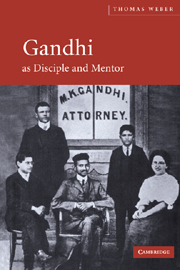Book contents
- Frontmatter
- Contents
- Notes
- Preface
- Glossary
- PART I INFLUENCE
- PART II GANDHI INFLUENCED
- 2 The influenced Gandhi
- 3 Henry Polak and the setting up of Phoenix Settlement
- 4 Hermann Kallenbach and the move to Tolstoy Farm
- 5 Maganlal Gandhi and the decision to leave Sabarmati
- 6 Jamnalal Bajaj and the move to Sevagram
- 7 The top of the hourglass: Gandhi influenced
- PART III GANDHI'S INFLUENCE
- Bibliography
- Index
5 - Maganlal Gandhi and the decision to leave Sabarmati
Published online by Cambridge University Press: 22 September 2009
- Frontmatter
- Contents
- Notes
- Preface
- Glossary
- PART I INFLUENCE
- PART II GANDHI INFLUENCED
- 2 The influenced Gandhi
- 3 Henry Polak and the setting up of Phoenix Settlement
- 4 Hermann Kallenbach and the move to Tolstoy Farm
- 5 Maganlal Gandhi and the decision to leave Sabarmati
- 6 Jamnalal Bajaj and the move to Sevagram
- 7 The top of the hourglass: Gandhi influenced
- PART III GANDHI'S INFLUENCE
- Bibliography
- Index
Summary
INTRODUCTION
The original buildings of Gandhi's Harijan Ashram at Sabarmati in Ahmedabad are striking in their simple aesthetics. Here beauty, a sense of peace and feeling of functionality are combined. Gandhi and Kasturba's home, Hriday Kunj, with its courtyard and large veranda and the small hut, used at different times by Vinoba Bhave and Mirabehn, along with the nearby prayer ground are at the heart of the complex. It is to here that tourists wander after they have been through the more recently erected picture galleries. But there is much more to the ashram. There are workshops, guest quarters and, now over busy Ashram Road, the living quarters of many of the families who once resided there. Possibly, however, the most imposing single household building, in a corner of the main complex near a small temple, one that until recently was locked up and rarely visited, is Magan Niwas, the once home of Gandhi's second cousin, the ashram's manager, Maganlal Gandhi.
I was at the ashram for a long period in 1982–3. I walked the grounds daily, often meditated in the prayer grounds in the early mornings, sat on the veranda of Gandhi's house while trying to learn to spin with diminutive ashram resident Mangaldasbhai, leaned over the wall in the evenings watching the buffalos being taken along the generally almost dry river-bed of the Sabarmati between the ashram and the textile mills on the opposite bank, and watched the bright green parrots as they flitted around.
- Type
- Chapter
- Information
- Gandhi as Disciple and Mentor , pp. 84 - 101Publisher: Cambridge University PressPrint publication year: 2004



